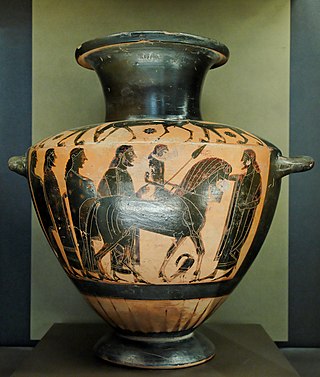
Lydos was an Attic vase painter in the black-figure style. Active between about 560 and 540 BC, he was the main representative of the '’’Lydos Group’’’. His signature, ό Λυδός, ho Lydos ", inscribed on two vases, is informative regarding the cultural background of the artist. Either he immigrated to Athens from the Lydian empire of King Kroisos, or he was born in Athens as the son of Lydian parents. In any case, he learned his trade in Athens.

The Athena Painter was an Attic black-figure vase painter, active about 490 to 460 BC. His speciality were white-ground lekythoi painted in the black-figure style.

The N Painter was an Attic black-figure vase painter of the third quarter of the 6th century BC. His real name remains unknown.

The Painter of Berlin A 34 was a vase painter during the pioneering period of Attic black-figure pottery. His real name is unknown, his conventional name derived from his name vase in the Antikensammlung Berlin. He is the first individual vase painter of the style in Athens recognised by scholarship. His works are dated to circa 630 BC. Two of his vases were discovered in Aegina. Since the 19th century, those pieces were on display in Berlin, but they disappeared or were destroyed during the Second World War.
The Panther Painter was a vase painter of the Attic black-figure style. He was probably active at the same time as the Nessos Painter, or shortly thereafter. Both shared a predilection for interlace patterns. The Panther Painter's vases have so far only been found in Attica, but outside Athens, at Vari. It is therefore assumed that he did not live and work in Athens, but only produced for a small local market in Attica. He mainly painted lekanis with animal friezes.

The Polos Painter was a vase painter of the Attic black-figure style. His works date to c. 575 to 565 BC.

The Painter of Acropolis 606 was a black-figure vase painter, active around 570–560 BC.

The C Painter was one of the most important Attic black-figure vase painters. His works date to circa 575–550 BC. His conventional name was allocated by the archaeologist John Beazley. The C stands for "Corinthianising", a reference to the strong influence of Corinthian vase painting on the artist. He was successor to the Comast Group and used the relatively old-fashioned range of vessel shapes preferred by that group, including lekanis, tripod kothon and skyphos. In contrast, he also painted quite innovative lekythoi with pronounced shoulders, although the more conservative Deinaeira type was still in use by some workshops at his time. The C Painter was the first Attic vase painter to paint cups without an offset lip, the Merrythought cup.

The Castellani Painter was an Attic vase painter of the black-figure style active in the second quarter of the sixth century BC.

The Goltyr Painter was an Attic vase painter of the black-figure style. He was active in the second quarter of the sixth century BC. He is well known for his work on Tyrrhenian amphorae. He mostly painted animals, often with rather bulbous heads.

Group E was a group of Attic vase painters of the black-figure style. They were active between 560 and 540 BC.

Eye-cup is the term describing a specific cup type in ancient Greek pottery, distinguished by pairs of eyes painted on the external surface.
The Xenokles Painter was an Attic vase painter in the black-figure style, active around the middle of the 6th century BC. His real name is unknown. His conventional name is based on the fact that he often painted vases made by the potter Xenokles, with whom he may be identical. In artistic terms, he did not reach the talent of comparable painters, such as the Tleson Painter. Characteristic of his work is his habit of cramming lip cups with figures, comparable to the normal decoration of Siana cups.

The BMN Painter was an Attic vase painter in the black-figure style, active during the third quarter of the 6th century BC.
The Daybreak Painter was an Attic black-figure vase painter, active in the late sixth and early fifth centuries BC. His real name is not known.

The Swing Painter was an Attic black-figure vase painter, active in the third quarter of the sixth century BC. His real name is unknown.

The Rycroft Painter was an Attic late black-figure vase painter, active in the final decade of the sixth century BC. His real name is not known.

The Madrid Painter was an Attic black-figure vase painter active during the late period of the style, around 520 BC.

The Nikoxenos Painter was an Attic vase painter who worked in both the black-figure and red-figure styles. He was active in the end of the sixth and the beginning of the fifth centuries BC. His real name is not known.
The Beldam Painter was an Attic black-figure vase painter, active from around 470 to before 450 BC.
















